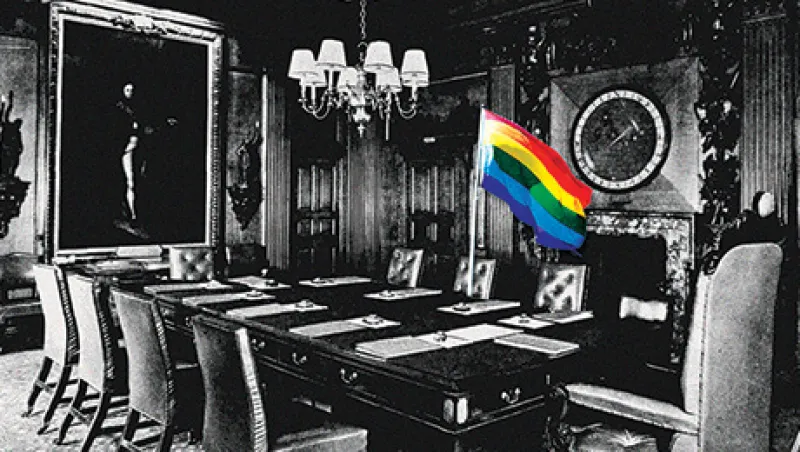This article was originally published August, 2017.
Apple’s Tim Cook is an openly gay board member and chief executive of a Fortune 500 company. Can you name any other openly lesbian, gay, bisexual or transgender (LGBT) board members of major public companies in the U.S. or elsewhere?
Out Leadership, a New York-based group that supports LGBT people in business, estimates that only 10 board members of Fortune 500 companies — or 0.3 percent — are openly gay. It seeks to change that.
The group, whose advisory board members include Goldman Sachs Group CEO Lloyd Blankfein and KKR & Co.’s global head of public affairs Ken Mehlman, started Quorum in 2015 with founding global sponsor KPMG to identify and help place senior LGBT executives on boards. It’s trying to reshape the corporate landscape when almost all of the conversation around board diversity today focuses on women and people of color.
“There is a missed opportunity there,” says Out Leadership founder Todd Sears.
Companies also need to hear from people with different sexual and gender orientations. At companies, and among investors, the issue of board diversity has become a significant one. Adding LGBT representation to the list “just expands the pool” of candidates, Sears says.
Out Leadership has been working with the New York City Retirement System to encourage pension plans to speak out on the matter and engage with company executives. The group aims to create a cohort of comptrollers and treasurers “who are like minded and who are willing to have the conversation,” Sears says.
“We are looking not just at the Fortune 500, but also at the middle markets,” he adds.
In May 2016, Sears and New York City Comptroller Scott Stringer co-authored a thought piece on expanding diversity on boards. The city’s pension funds were “among the first major U.S. institutional investors to approve an LGBT-inclusive director standard for the companies in which they invest billions of dollars,” they wrote.
Sears knows the finance world, having started his career in the sector as an investment banker. He later became a private wealth advisor at Merrill Lynch, before the firm’s 2009 purchase by Bank of America. At Merrill, he built the first national team of financial advisors focused on the needs of LGBT clients, expanding related assets to more than $1.5 billion. Sears then moved into management, serving as head of strategic initiatives for the brokerage firm’s office of diversity. After that, he joined Credit Suisse Group, where he was head of diversity and inclusion for the Americas.
Out Leadership’s first initiative, Out on the Street, was started in 2011 to connect senior LGBT executives with allies at major financial firms. The idea is to spur “crucial innovations at the intersection of business” and the LGBT community, according to the group’s website.
One of Sears’s key insights from the beginning was to form an organization that’s neither activist driven – though Out Leadership does advocate globally for LGBT rights – nor purely a human resources conversation.
The challenge of how best to support gay employees is an important part of his efforts. Sears wants to make the case for LGBT inclusion while convincing senior management to think seriously about issues the community faces in society and the workplace.
This business-orientated approach helped Out Leadership garner significant support from financial-services firms before other industries stepped up as well. The group now has more than 70 member companies, up from six in 2011, according to its website.
About five years ago, Goldman’s Blankfein threw his weight behind one of Out Leadership’s earliest priorities: the campaign for marriage equality.
He emerged in 2012 as the first CEO of a Fortune 500 company to lend his support to the campaign, even producing a 30-second video segment on the topic. The U.S. Supreme Court bolstered gay marriage with two rulings the following year, and in 2015 made it a constitutional right.
“Lloyd was my guinea pig,” says Sears. “After marriage equity,” he adds, “What’s next?”
There are still plenty of issues to tackle, including stronger rights and protections for LGBT people outside the U.S. Indonesia has seen a rise in violence against LGBT community; in Singapore it likewise continues to be very difficult to live as an openly gay or transgendered person. In these two countries, and elsewhere in the global business community, Out Leadership has been an important ally and advocate for local LBGT communities.
Meanwhile, in the U.S., in many states it remains possible to be fired just for being gay. Sears says that 92 percent of Americans think you can’t be fired for being gay, when, in fact, in many states it is perfectly legal to do so.
“I find a lot of gay people that don’t know that, which blows my mind,” he says.
“A lot of people don’t realize you could be married on Saturday or Sunday” to a same sex partner, he says, “and go to work on Monday and be fired in 29 states, 34 if you’re trans.”
Proof that, even in the U.S., there are still plenty of battles to be won.






